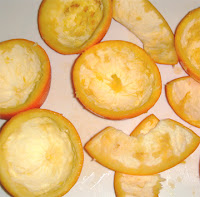 Over on Crunchy Chicken I'm describing how I'm turning some of my food scraps into delectable foods. Candied orange peels are no different.
Over on Crunchy Chicken I'm describing how I'm turning some of my food scraps into delectable foods. Candied orange peels are no different. You can modify this recipe to make more or less.
Ingredients:
Peels from 5 medium size organic oranges
4 cups granulated sugar
2.5 cups water
6 oz milk chocolate (for dipping, if desired)
The process is fairly easy.
Step 1. Scrape the inside of the orange peels to remove the residual orange from the pith. If the pith is really thick, scrape it out with a vegetable peeler or a knife.

Step 2. Cut the peels into strips about 1/4" in width, removing the parts where the stem and the orange end are and any parts that don't look good.

Step 3. Put the strips into a medium sauce pan and cover with cold water. Bring the water to a boil to blanch the peels. This helps remove the bitterness of the pith. Repeat the blanching process one more time (if you removed a lot of the pith) or two more times if you left a lot of the pith on (like I did).

Step 4. Drain the peels and rinse with cold water. In the same saucepan add the water and sugar and bring to a boil. It will start to boil somewhere around 210 degrees F.

Step 5. Once the sugar syrup is boiling, add the peels and bring the temperature back up to boiling. Simmer the peels on medium low until they become translucent. Depending on how much pith is on the peel this will take anywhere from 1/2 an hour to 1 hour and 15 minutes (this is how long it took mine).

Step 6. When the peels are looking translucent, use a pair of tongs and remove them from the pot, placing them on a rack set over a cookie sheet to catch the drips. If you want you can roll the freshly removed strips in additional sugar but I found this to be a huge mess.
[You can strain the sugar syrup and use it as a simple syrup in a variety of recipes - just make sure you refrigerate it.]

Step 7. Leave the peels out to dry. If you want to speed things up you can put the whole cookie tray/rack combo in the oven at 250 degrees F for an hour or two.
Step 8. If you want to dip the strips in chocolate, melt the milk chocolate over a double boiler and dip, laying the strips down on parchment paper to dry.















